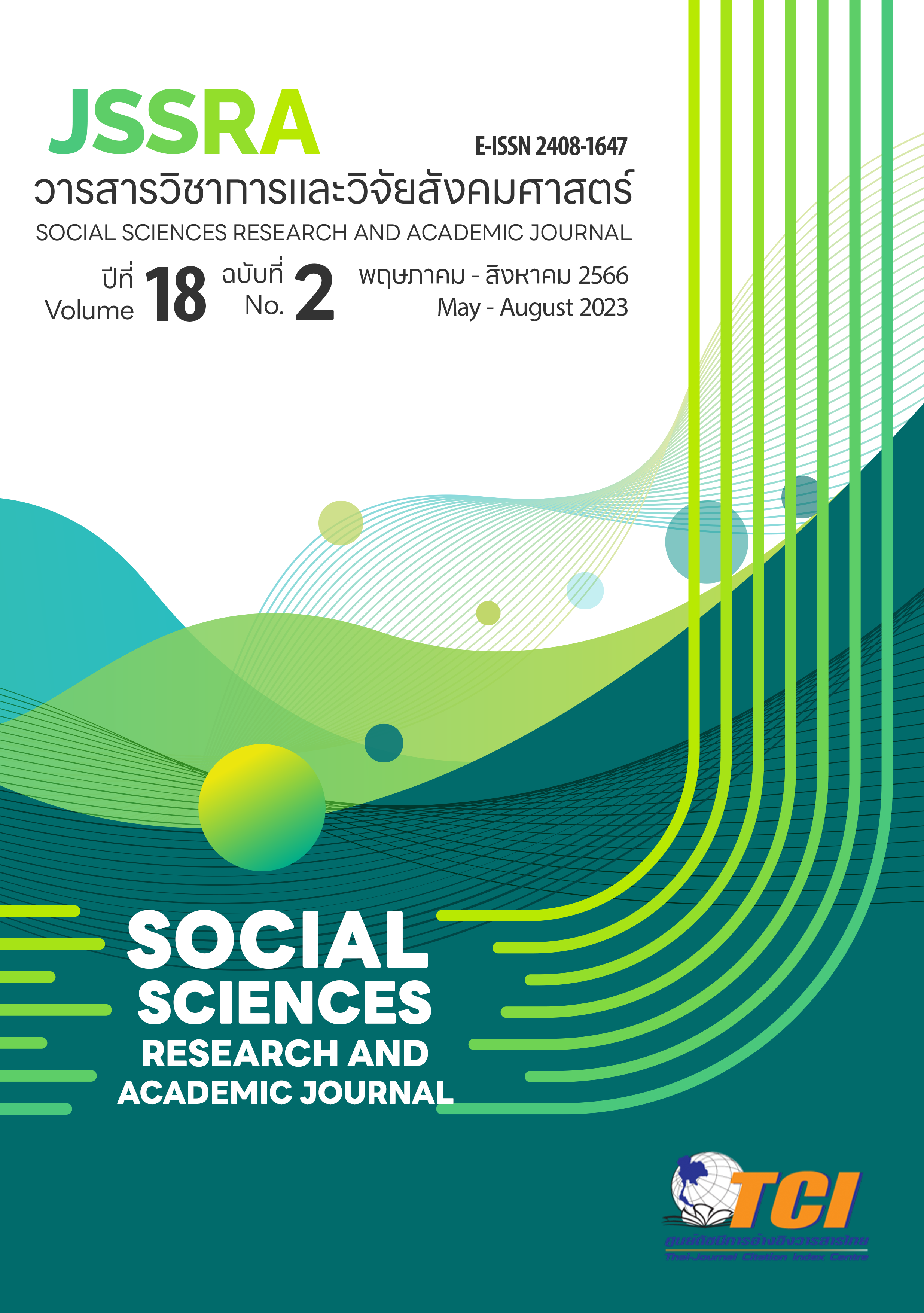การพัฒนารูปแบบการเรียนการสอนโดยใช้บริบทเป็นฐานร่วมกับระบบสารสนเทศภูมิศาสตร์ เพื่อส่งเสริมความสามารถในการแก้ปัญหาอย่างสร้างสรรค์ สำหรับนักเรียนระดับชั้นมัธยมศึกษาตอนปลาย
Main Article Content
บทคัดย่อ
การวิจัยในครั้งนี้มีวัตถุประสงค์เพื่อพัฒนารูปแบบการเรียนการสอนโดยใช้บริบทเป็นฐานและระบบสารสนเทศภูมิศาสตร์ เพื่อส่งเสริมความสามารถในการแก้ปัญหาอย่างสร้างสรรค์ สำหรับนักเรียนระดับชั้นมัธยมศึกษาตอนปลาย ซึ่งมีการดำเนินการตามกระบวนการวิจัยและพัฒนา 4 ขั้นตอน ได้แก่ 1) ศึกษาข้อมูลพื้นฐานในการพัฒนารูปแบบการเรียนการสอน 2) สร้างและตรวจสอบคุณภาพ 3) ศึกษาผลการใช้รูปแบบการเรียนการสอน โดยการนำไปใช้กับกลุ่มตัวอย่าง ได้แก่ นักเรียนชั้นมัธยมศึกษาปีที่ 6 โรงเรียนนวมินทราชูทิศ มัชฌิม จำนวน 21 คน และ 4) ประเมินการใช้รูปแบบ ผลการวิจัยพบว่า 1) สภาพการแก้ปัญหาอย่างสร้างสรรค์ของนักเรียนในปัจจุบันอยู่ในระดับปานกลาง (= 2.96, S.D. = 0.93) ความสามารถในการแก้ปัญหาอย่างสร้างสรรค์ของนักเรียนมีคะแนนเฉลี่ยเท่ากับ 16.98 คิดเป็นร้อยละ 56.58 2) การพัฒนารูปแบบการเรียนการสอนที่พัฒนาขึ้น ประกอบด้วย 1) หลักการ 2) วัตถุประสงค์ 3) เนื้อหา 4) กระบวนการเรียนการสอน 6 ขั้นตอน คือ 1) ค้นพบปัญหาจากบริบท 2) รวบรวมข้อมูลเชิงพื้นที่ 3) วิเคราะห์วิธีการแก้ปัญหา 4) ออกแบบกระบวนการแก้ปัญหา 5) แสดงผลการแก้ปัญหา 6) ประยุกต์ใช้ในบริบท และ 5) การวัดและประเมินผล ซึ่งผลการตรวจสอบคุณภาพมีความเหมาะสมอยู่ในระดับมาก และมีค่าดัชนีประสิทธิผล (E.I.) เท่ากับ 0.71 3) ผลการทดลองใช้รูปแบบการเรียนการสอนที่พัฒนาขึ้น พบว่า นักเรียนที่ได้รับการจัดการเรียนรู้ตามรูปแบบการเรียนการสอนมีความสามารถในการแก้ปัญหาอย่างสร้างสรรค์ตามองค์ประกอบในการเรียนครบทุกด้าน และมีความสามารถในการแก้ปัญหาอย่างสร้างสรรค์หลังเรียนสูงกว่าเกณฑ์ร้อยละ 70 อย่างมีนัยสำคัญทางสถิติที่ระดับ .01 และ 4) นักเรียนที่ได้รับการจัดการเรียนการสอนมีความคิดเห็นต่อรูปแบบการจัดการเรียนการสอนอยู่ในระดับมาก (
= 4.13, S.D. = 0.62)
Article Details
เอกสารอ้างอิง
ทิศนา แขมมณี. (2544). กระบวนการเรียนรู้ ความหมาย แนวทางการพัฒนา และปัญหาข้องใจ. กรุงเทพฯ: พัฒนาคุณภาพวิชาการ (พว.).
ภัทรี สุรโรจน์ประจักษ์. (2558). การพัฒนากระบวนการแก้ปัญหาตามแนวคิดการเรียนรู้โดยใช้ความท้าทายเป็นฐานผสมผสานแนวคิดกระบวนการวางกลยุทธ์ เพื่อส่งเสริมความสามารถในการแก้ปัญหาอย่างสร้างสรรค์ของนักเรียนระดับชั้นประถมศึกษา. ดุษฎีนิพนธ์ครุศาสตรดุษฎีบัณฑิต, จุฬาลงกรณมหาวิทยาลัย, กรุงเทพฯ.
สรรค์ใจ กลิ่นดาว. (2542). ระบบสารสนเทศภูมิศาสตร์: หลักการเบื้องต้น. (พิมพ์ครั้งที่ 2). กรุงเทพฯ: สำนักพิมพ์แห่งมหาวิทยาลัยธรรมศาสตร์.
สุธาสินี ศรีวิชัย. (2561). การพัฒนารูปแบบการเรียนการสอนตามแนวคิดการเรียนเรียนรู้อย่างมีความสุข เพื่อส่งเสริมความเป็นกัลยาณมิตรสำหรับนักศึกษาครู มหาวิทยาลัยราชภัฏ. ดุษฎีนิพนธ์การศึกษาดุษฎีบัณฑิต, มหาวิทยาลัยนเรศวร, พิษณุโลก.
สุนันทา พุฒพันธ์. (2559). การพัฒนารูปแบบการจัดการเรียนรู้เพื่อเสริมสร้างสมรรถนะการคิดแก้ปัญหาอย่างสร้างสรรค์ของผู้เรียนตามแนวทฤษฎีเชื่อมโยงนิยม. ดุษฎีนิพนธ์ปรัชญาดุษฎีบัณฑิต, มหาวิทยาลัยขอนแก่น, ขอนแก่น.
สุเพชร จิรขจรกุล. (2552). การเรียนรู้ระบบภูมิสารสนเทศด้วยโปรแกรม ArcGIS Desktop 9.3.1. กรุงเทพฯ: เอส.อาร์ พริ้นติ้ง แมสโปรดักส์.
สำนักงานปลัดกระทรวงศึกษาธิการ. (2554). แผนพัฒนาการศึกษาของกระทรวงศึกษาธิการฉบับที่ 11 พ.ศ. 2555-2559. กรุงเทพฯ: สำนักงานปลัดกระทรวงศึกษาธิการ.
สำนักงานเลขาธิการสภาการศึกษา. (2560). แผนการศึกษาชาติ พ.ศ. 2560-2579. กรุงเทพฯ: พริกหวานกราฟฟิค.
สำนักวิชาการและมาตรฐานการศึกษา. (2560). ตัวชี้วัดและสาระการเรียนรู้แกนกลาง สาระภูมิศาสตร์ (ฉบับปรับปรุง พ.ศ. 2560) กลุ่มสาระการเรียนรู้สังคมศึกษา ศาสนา และวัฒนธรรม ตามหลักสูตรแกนกลางการศึกษาขั้นพื้นฐาน พุทธศักราช 2551 และแนวการจัดกิจกรรมการเรียนรู้. กรุงเทพฯ: โรงพิมพ์ชุมนุมสหกรณ์การเกษตรแห่งประเทศไทย.
Akers, J.B. (1999). Confronting the Realities of Implementing Contextual Learning Ideas in a Biology Classroom. (Unpublished doctoral dissertation). Virginia Polytechnic Institute and State University, United States.
Anderson, T.P. (1997). Using models of Instruction. In C. R. Dills and A.J. RomisZowski (eds.), Instructional development paradigms. Englewood Cliffs, NJ: Education Technology Publications.
Chang, K. (2012). Introduction to Geographic Information Systems, Sixth Edition. New York: McGraw-Hill.
Gilbert, J. k. (2006). On the nature of “context” in chemical education. International Journal of Science Education, 28(9), pp. 957-976.
Godfrey, B. and Stoddart, R. (2018). Managing In-Library Use Data: Putting a Web Geographic Information Systems Platform through its Paces. Information Technology and Libraries, 37(2), pp. 34-49.
Incebacak and Ersoy (2018). Creative Problem Solving Skills of Secondary School Students. Necatibey Faculty of Education Electronic Journal of Science and Mathematics Education, 12(1), pp. 1-24.
Isaksen, S.G. (1995). On The Conceptual Foundation of Creative Problem: A Response to Magyari-Beck. Creativity and Innovation Management, 1(3), pp. 52-63.
Isaksen, S.G., Dorvol, K.B., and Treffinger, D.J. (2011). Creative Approaches to Problem Solving. los Angeles: Sage.
Joyce, B., and Weil, M. (2004). Model of Teaching. (7thed). London: Allyn & Bacon.
Lewin, J.,and Reed, P.(1998). Creative problem solving in occupational therapy. philadelphia: Lippincott-Raven.
Osborn, A.F. (1963). Applied Imagination: Principles and procedures of creative thinking. (3rd ed). New York: Charles Scribner’s sons.
Warren, B. (2006). The Influence of Science Standard Regulation on Teacher Quality and Curriculum Renewal: An Australia Perspective. In Sunal, Dennis W. and Wright Emmett L. The Impact of state and National Standard on K-12 Science Teaching.


